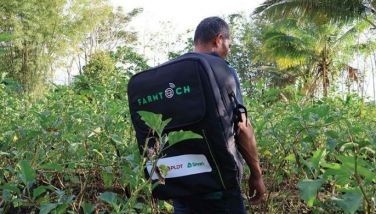Anti-cancer compounds found in Guyabano fruit
CEBU, Philippines - Scientists have isolated six compounds from the guyabano fruit (scientific name, Annonamuricata Linn.) which are known to fight cancer, diabetes, heart ailment and tuberculosis.
Writing in a recent issue of the Silliman Journal, the researchers identified the following six compounds from the guyabano fruit which are known to have significant medicinal effects: beta-sitosterone (1), beta-sitosteryl fatty acid ester (2), beta-sitosterol (3, ) alpha-amyrin (4), beta-amyrin (5), and squalene (6).
“To the best of our knowledge, this is the first report on the isolation of 1-6 from A. muricata,” wroteConsolacion Y. Ragasa, Oscar B. Torres and Geneveve Soriano of the chemistry department and Center for Natural Sciences and Ecological Research, De La Salle University Manila, and Chien-Chang Shen of the National Research Institute of Chinese Medicine in Taipei, Taiwan.
The researchers collected the A. muricata fruits from Painaan, Rizal, and had them authenticated at the Bureau of Plant Industry in Manila.
After a series of laboratory tests identifying the six compounds, the researchers then cited earlier studies on the compounds’ medicinal properties: Beta-sitosteronewas reported to fight high blood sugar, irregular heartbeat and tuberculosis.
Beta-sitosterolwas shown to have inhibited the spread and induced the destruction of colon and breast cancer.
Alpha-amyrinand Beta-amyrinwere reported to have anti-inflammatory and analgesic properties.
Squalenewas reported to suppress colonic cancer cells and to protect the heart by its ability to prevent the build-up of lipid.
In their review of the literature, the authors cited other anti-cancer substances found in the guyabano plant:
“The bioactivities of A. muricata are varied, but the commonly isolated compounds are acetogenins which are known for their anticancer properties.”
The substance called annohexocin, an acetogenin from guyabano leaves, showed “significant inhibitory effect against six human cancer cell lines: lung, breast, colon, pancreatic, kidney and prostate.”
Similary, the substances muricoreacin and murihexocin C, also found in the leaves of the guyabano plant, “exhibited significant cytotoxicities against six human tumor cell lines,” specifically prostate and pancreatic cancer.
Moreover, annomuricine and muricapentocin “showed significant cytotoxicities” against six types of human tumors, specifically pancreatic and colon cancer lines.
In their own earlier work, the authors reported that they had isolated three acetogenins from guyabano(cis-annoreticuin and sabadelinfrom the pulp,and annoreticuin-9-one from the seeds) which worked against six types of human tumors in the pancreas, prostate and lungs.
Their latest report was published in the Silliman Journal, Vol. 54, No. 1, January to June, 2013.
The Silliman Journal is the official research publication of Silliman University (since 1954). It comes out semi-annually and enjoys exchange arrangements with more than 200 academic/research journals in the Philippines and abroad.
It has been recognized by the Philippine Commission on Higher Educationas one of the top internationally refereed academic journals in the country.
*Article contributed by Celia E. Acedo, Silliman University College of Mass Communication (FREEMAN)
- Latest

























